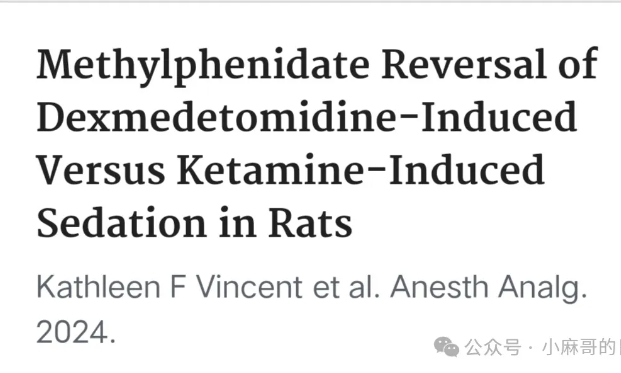来源:新青年麻醉论坛

摘要译文(供参考)
哌醋甲酯逆转右美托咪定与氯胺酮诱导的镇静作用
背景:
右美托咪定和氯胺酮在人体中具有较长的消除半衰期,且无临床批准的拮抗剂。哌醋甲酯通过抑制多巴胺能和去甲肾上腺素能神经递质的再摄取转运蛋白来增强多巴胺能和去甲肾上腺素能神经递质。先前在大鼠中的研究表明,静脉注射哌醋甲酯可诱导异氟醚和丙泊酚全身麻醉苏醒。认为这2种麻醉剂主要通过增强抑制性γ-氨基丁酸A型(GABAA)受体起作用。在本研究中,我们在大鼠中测试了哌醋甲酯在低剂量和高剂量右美托咪定(一种α-2肾上腺素能受体激动剂)和氯胺酮(一种N-甲基-D-天冬氨酸[NMDA]受体拮抗剂)分别诱导镇静和意识丧失后的行为和神经生理学影响。
方法:
所有实验均使用成年雄性和雌性Sprague-Dawley大鼠(共32只),所有药物均以交叉、盲态实验设计静脉给药。采用旷场试验(n=16)检测了右美托咪定(10μg/kg)或氯胺酮(10mg/kg)与或不与哌醋甲酯(5mg/kg)一起镇静给药后的运动(n=16)。在第二组大鼠(n=8)中评估了高剂量右美托咪定(50μg/kg)或高剂量氯胺酮(50mg/kg)加或不加哌醋甲酯(1-5mg/kg)后翻正反射的恢复情况。最后,在第三组大鼠(n=8)中,记录额脑电图(EEG),用于在低剂量和高剂量右美托咪定和氯胺酮与或不与哌醋甲酯的情况下进行光谱分析。
结果:
低剂量右美托咪定使大鼠的运动减少94%。低剂量右美托咪定后哌醋甲酯可恢复运动(秩差=88.5,95%可信区间[CI],70.8-106),与多巴胺D1受体拮抗剂联合给药可阻断该效应(秩差=86.2,95%CI,68.6-104)。低剂量氯胺酮可使大鼠的翻正反射潜伏期一过性减低58%,哌醋甲酯对其无改善作用,但对大剂量右美托咪定和氯胺酮后翻正反射潜伏期的恢复均无影响。额叶EEG分析显示哌醋甲酯逆转了低剂量右美托咪定引起的光谱变化(F[8,87]=3.27,P=.003),但高剂量右美托咪定后仅产生短暂的变化。低剂量或高剂量氯胺酮给药后,哌醋甲酯均未引起脑电图的光谱改变。
结论:
哌醋甲酯逆转右美托咪定诱导的镇静行为和神经生理学相关性,但不逆转无意识。相反,哌醋甲酯不影响氯胺酮后大鼠的镇静、意识丧失和脑电图特征。这些发现表明哌醋甲酯可能有效地逆转右美托咪定在人体中的镇静。
原文摘要
Methylphenidate Reversal of Dexmedetomidine-Induced Versus Ketamine-Induced Sedation in Rats
Background: Dexmedetomidine and ketamine have long elimination half-lives in humans and have no clinically approved reversal agents. Methylphenidate enhances dopaminergic and noradrenergic neurotransmission by inhibiting reuptake transporters for these arousal-promoting neurotransmitters. Previous studies in rats demonstrated that intravenous methylphenidate induces emergence from isoflurane and propofol general anesthesia. These 2 anesthetics are thought to act primarily through enhancement of inhibitory Gamma-aminobutyric acid type A (GABAA) receptors. In this study, we tested the behavioral and neurophysiological effects of methylphenidate in rats after low and high doses of dexmedetomidine (an alpha-2 adrenergic receptor agonist) and ketamine (an N-methyl-D-aspartate [NMDA] receptor antagonist) that induce sedation and unconsciousness, respectively.
Methods: All experiments used adult male and female Sprague-Dawley rats (n = 32 total) and all drugs were administered intravenously in a crossover, blinded experimental design. Locomotion after sedating doses of dexmedetomidine (10 µg/kg) or ketamine (10 mg/kg) with and without methylphenidate (5 mg/kg) was tested using the open field test (n = 16). Recovery of righting reflex after either high-dose dexmedetomidine (50 µg/kg) or high-dose ketamine (50 mg/kg) with and without methylphenidate (1-5 mg/kg) was assessed in a second cohort of rats (n = 8). Finally, in a third cohort of rats (n = 8), frontal electroencephalography (EEG) was recorded for spectral analysis under both low and high doses of dexmedetomidine and ketamine with and without methylphenidate.
Results: Low-dose dexmedetomidine reduced locomotion by 94% in rats. Methylphenidate restored locomotion after low-dose dexmedetomidine (rank difference = 88.5, 95% confidence interval [CI], 70.8-106) and the effect was blocked by coadministration with a dopamine D1 receptor antagonist (rank difference = 86.2, 95% CI, 68.6-104). Low-dose ketamine transiently attenuated mobility by 58% and was not improved with methylphenidate. Methylphenidate did not affect the return of righting reflex latency in rats after high-dose dexmedetomidine nor ketamine. Frontal EEG analysis revealed that methylphenidate reversed spectral changes induced by low-dose dexmedetomidine (F [8,87] = 3.27, P = .003) but produced only transient changes after high-dose dexmedetomidine. Methylphenidate did not induce spectral changes in the EEG after low- or high-dose ketamine.
Conclusions: Methylphenidate reversed behavioral and neurophysiological correlates of sedation, but not unconsciousness, induced by dexmedetomidine. In contrast, methylphenidate did not affect sedation, unconsciousness, nor EEG signatures in rats after ketamine. These findings suggest that methylphenidate may be efficacious to reverse dexmedetomidine sedation in humans.